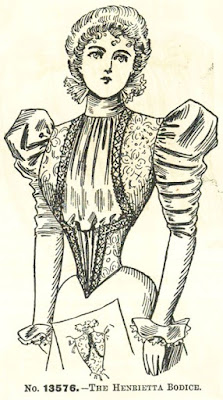What is the difference between a bodice and a blouse? By the 1890s, not much:
In brief, the main difference seems to have been that a blouse could be worn with any contrasting skirt, whereas a bodice was intended to be worn with only one matching skirt. Most of the patterns illustrated below are described as "blouses", but it's quite easy to imagine a dressmaker making up a matching skirt for some of these and turning them into "bodices"."...by 1890 a blouse had become more than the occasional garment of informal wear. It became so much worn that in part it lost its original difference from the bodice, and many blouses of the 1890s are as rigidly boned as any of the dress bodices."Anne M. Buck Victorian Costume and Costume Accessories (1961)
The "Phyllis Blouse" designed for two materials "such as chequered, flowered or plain silk or satin, crȇpon, cachemire, &c., combined with plain soft silk or chiffon". Excess fabric is "gathered" at the waist and the shoulders.
The "Lydia Blouse" is described as a "dressy design, for fancy silk or satin" and is enlivened with lace, tucks, gathers and frills. A box pleat (lined with muslin) runs down the front, no doubt in order to conceal the fastenings at the front.
The Ellaline Blouse, double breasted and "suited to fancy and plain silk, trimmed with insertion or lace, braid or beads".
Pattern no. 13617—simply described as "a smocked blouse" and appears very much plainer than most of the blouses featured in this issue of Weldon's Ladies' Journal. There is no detailed description of the pattern in the magazine, the editors claiming they lacked room for it in the issue.
And lastly, a "bodice"—"The Henrietta Bodice"! The corselet and the "Zouave part" of this design are to be made of coarse lace over coloured silk or satin and the band collar mounted on canvas. The whole is fastened down the centre with hooks and eyes.








No comments:
Post a Comment